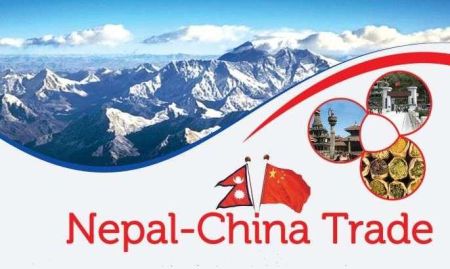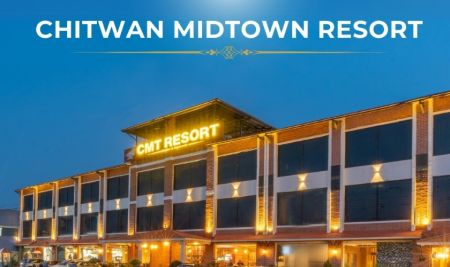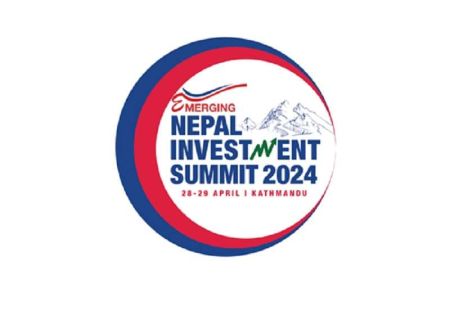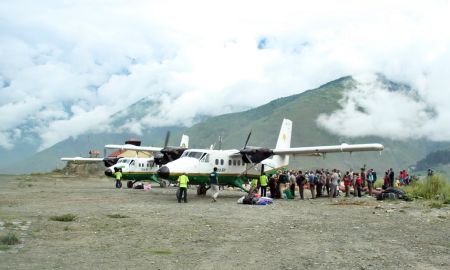“It is high time for us to have brand management and boutique design agencies”
 Nabin Shrestha
Nabin Shrestha
Managing Director
Water Communication
How do you see the changing landscape of the Nepali advertisement industry?
Over the years, the advertisement market has grown significantly. As business activities have increased notably and the media’s penetration has increased dramatically, advertisements have also surged quantity wise. Nevertheless, in terms of creativity and branding we lag behind.
What factors are holding back creativity in Nepali advertisements?
Advertisements won’t be creative if the objectives are not clear. There is a communication gap between the advertisement agencies and advertisers. The clients do not properly brief their agencies about the products and services they launch or introduce into the market. Similarly, the agencies do not usually go to their clients with proper homework. If we want our advertisements to be effective, the briefing and outline must be clear. Similarly, the definition of creativity is not clear in our context. The agencies and their clients see creativity differently. All these factors ultimately lead to ineffective outputs.
How do you define creativity?
There is a perception in the industry that layout is creativity. We just swap logos of brands which at times are hard to recognise. Creativity is just one part of the advertising business. Management and positioning of brands are largely absent in our industry. Out of 100 less than two percent companies are serious on the brand management cycle. When the proper roadmap of the brand management is not clear, the advertisement campaigns are conducted on an ad-hoc basis with short-term results only. Creativity should be linked with design, marketing, media planning and client servicing.
Is the budget an issue in terms of increasing creativity?
It has been debated many times. I do not see any link between creativity and the budget. If we look at the many award winning advertisements globally, they have incorporated simple concepts. Creative advertisements need to be straightforward, understandable to all and entertaining as well. Creativity is simplicity and exciting ways to communicate.
Nevertheless, the size of the budget can impact the production side of the advertisements. With higher budgets , advertisements can grow higher numerically.
The low level of creativity in the Nepali advertisements is also attributed to the declining creative workforce in the industry. How can we address the problem?
It is an irony that such an important industry has only a handful of trained professionals. I think the Nepali advertising sector only has 4-5 percent trained professionals. Many people who are in the industry have acquired their skills through ‘learning by doing’ approach. However, there is a big gap between the fundamental basics of creativity and practical approach.
We do not have dedicated courses of advertisements in our universities and colleges. A very few design colleges exist in the country at present but they are in a nascent stage. The courses run by the Kathmandu University and trainings conducted by AAN on an annual basis are not sufficient to produce skilled manpower for the industry.
How can proper brand management impact the advertisements?
Brand management is an integral part of any marketing campaign. If we can handle the brand management side effectively, advertisements will become more efficient. The agencies as well as the advertisers should have the knowledge about fundamentals of advertisement. It is essential to know the brand management before agencies and their clients embark on advertisement campaigns of products and services.
How do you view the lack of a proper categorisation of advertising companies at present?
Most of the companies in the Nepali advertising sector are media agencies. They are not advertising agencies. We do not have brand management and consulting agencies. It is high time for us to have brand management, consulting and boutique design agencies that can cater to the needs of the clients properly. Globally, such verticals have more hold on the brand management of clients.
Is there a need for a regulatory mechanism for the ad industry?
Before pointing to the government regarding the regulatory mechanism, we need to focus on the problems that can be solved within the industry. We do not have a strategic collective vision and action plans for the industry. Similarly, we also lack unity as different people in the industry hold conflicting views on various issues that can be solved on collective grounds.
With the clean feed policy in place, Nepali agencies can produce advertisements of multinational clients locally relevant to the Nepali market benefitting both clients and agencies. It will also help bolster creativity as the production of advertising will increase.
Lack of valid data is one of the major problems in the sector. How can we collect valid data?
We have been working with our experience so far. With the market becoming more complex, we need to change the ways in which we work. Data is essential to the development of any industry as statistics and researches guide us to make conscious decisions about the return on investments in any industry. It is not rocket science to collect valid industry data. I suggest the engagement of third parties regarding the collection and compilation of statistics.
How is the shifting of media platform from the traditional to digital and social changing the advertisement industry?
Despite the huge growth of digital and social media over the past few years, traditional media still has a say here as Nepal is a developing country. Since the level of awareness of consumers is low compared to the developed market, print, television and radio have significant impact on the consumers. However, the pattern of consumption of information by the consumers in Nepal has been gradually changing to digital platform. They are spending more time on digital and social media. There is a clear need for advertising agencies and advertisers to adopt the change. Nevertheless, digital media are different from their traditional peers in terms of media planning and creativity strategies as people consume information interactively.
We need to first understand the psyche of consumers about the paradigm shift in the media platforms. I think the paradigm has shifted to ‘mobile first’ rather than the overall digital media. With the technological advancement, we need to have a different approach towards the creativity to enhance user experience and user interactivity. Different digital and social media platform have different uses. Activities of users are different in Snapchat and Viber from Facebook and Twitter. We need to model our advertising campaigns on that basis. Similarly, we also should be careful since the brand and marketing campaigns can have wildfire effects globally in the digital and social platforms compared to the traditional media.
How did last year’s unfortunate events affect the Nepali advertising industry? How has the recovery been like so far?
Nepali advertising industry went through the most depressing time in its history last year due to the earthquake and blockade. The advertising business declined by about 50 percent last year. Nonetheless, we survived the stress test which is a learning experience for us. The recovery thus has been good as businesses have swiftly resumed their activities after the end of the Terai stir.
There is a lot of potential in the Nepali market. We have a huge untapped market. Being small geographically, Nepal has a good population density. The purchasing power of Nepali consumers has grown significantly over the past one decade. However, there is a gap between the purchasing capacity of consumers and the ways the companies sell their products and services. If we can address this issue, Nepali advertising industry can grow exponentially.
What kind of services does Water Communication provide to its clients?
We used to do typical advertising agency work. But over the last two years we have changed our focus to become a brand management and design consulting company. After evaluating the health of the brands, we make roadmaps for our clients focusing on the execution of plans and return on investments. We help the clients to bridge the gap between the clients and agencies. Beyond the typical creativity work, we focus on packaging, point of sales, establishing the identity of brands, sub-branding, and user experiences.
Who are your top clients?
For the last 15 years, we have worked with the automobile industry, aviation, finance, development sector. Currently, we are working more for corporate clients and clients from the service sector. It is easy for us to connect with them.
“Advertising is a mix of creativity, strategy and media”
 Sudip Thapa
Sudip Thapa
Managing Director
ANS Creation
What factors are contributing to the changes in the Nepali advertising industry?
A swift change in the advertising industry began after the restoration of democracy in 1990. The main reason was the opening up of the economy. The media were also set free at the same time. Advertisingused to exist before democracy but there were no professional advertisement agencies at that time.
How can the Nepali advertisement industry develop?
Media, agencies, advertisers and consumers are the four integral parts of the advertising industry. We do not have a clear vision about the work we do. The mindset and common goal of these four parties should be clear in order to develop the Nepali advertisement industry. Advertising is a mix of creativity, strategy and media. The shortage of necessary human resources is another issue.
How do you view the cabinet endorsement of the clean feed policy? What impact can the policy have?
All stakeholders of the advertising industry including the agencies, advertisers and consumers have high hopes from the newly announced policy. It is the right of the consumers to have proper information about the brands. At present, consumers know about the brands through Indian and other internationaltelevision channels.With the implementation of the clean feed policy, consumers will get the information about the products in Nepali. Also, it will increase the revenue of advertisements benefiting both advertising agencies and the media bolstering the creativity and employment in the advertisement businessoverall.
The rise of digital and social media has opened the doors for the advertising and marketing sector. How is the Nepali advertising industry adopting this trend?
Traditional media and digital media have their own strengths. Digital and social media are parts of the technological revolution. Digital market is an experimental platform for advertising. Digital media can be a tool for integrated marketing but traditional media is needed for the establishment of brands. Conventional media is also necessary for the growth of digital and social media.
I think traditional media is more effective regarding the advertisements than their digital peers. Only a few brands and campaigns may reach higher levelsthrough digital and social media. We are also using the digital media as an experimental platform for our brands.
What are some of the ads created by ANS Creation that you consider notable?
We did a successful thematic campaign for Mahindra two-wheelers with the slogan “Feel the Thrill, Feel the Power.” We also created the ad for Jagadamba Cement which was developed based on our culture. Similarly we also created the Vodka ad for market regeneration. The advertisement of Posak Pellet Dana was another successful campaign.
Lack of creativity in advertisements is a long debated issue in the Nepali advertising industry. Do you think the budget is an issue here? Or are there other factors hindering the level of creativity?
We define creativity as a medium of communication. Budget is necessary to execute creative ideas and produce better advertisements. The sluggishness in the country’s economy can be identified as an attributing factor as advertisers tend to spend less during times like these. Beside this, lack of advanced technologies and manpower are other constraints for creativity.We will be happy if consumers appreciate our work not comparing it with Indian or other foreign ads. I do not agree with the notion that Nepali advertisements are not creative. We are creative even with the limited resources we have.Instead of arguing about the level of creativeness in Nepali advertisements, we need to focus our efforts on the areas where we can improve.
“Youths are unaware of the career scope in the advertising industry”
 Sudip Thapa
Sudip Thapa
Managing Director
ANS Creation
How did you get the idea of starting your own advertising agency?
Since my teens I was good in the creative field and I always wanted to make my career in this area. I have also been awarded for creativity during my high school. I jumped into the advertising sector realising that my job as a computer teacher was not my cup of tea. I have been in this field for 13 years now.
How difficult is it for women entrepreneurs to start a company in a sector dominated by men?
Actually, it is not that difficult, it is rather challenging. It is challenging because one has to prove their capabilities at every stage. Being a professional we have to work late nights to meet the deadlines and deliver the job demands. Nevertheless, we also have to manage our house as well. It's all about time management and women are capable enough to prove themselves in every step and under any circumstances. It requires confidence, determination and focus to achieve the objectives.
You have been appointed as the professional advertising coordinator at AAN. What are your roles?
My job is to conduct professional advertising training. I have to deal with expert trainers and trainees. I have already conducted two professional advertising training sessions. The main purpose of such training is to attract the youths to this field. Youths are still not much aware about the career opportunities in the advertising industry.
What advice would you give to a woman who wants to start an advertising business?
We women are very judgmental and self-critical. Being an entrepreneur, it allows me to be independent and deploy creativity in my work. Women can compete with men in every profession. The advertising business helps people to gain experience across different areas at the same time, such as marketing, designing, writing and public relations. Creative people can have immense opportunities in this field.
Who are your top clients?
I do not distinguish clients as big or small. I believe in clients who are active and they are top clients for me. Chaudhary Group, Dugar Group, Sujal Foods, Aero Bricks, Force Motors, Force Group, Techno Trade are some of the active clients for Munz Advertising.
How is the Nepali advertising sector recovering from the impacts of last year’s events?
Advertising, marketing and media businesses took a massive hit last year. The impact of the border blockade was much bigger than the earthquake. With the end of the border disturbances, the advertising sector has been gradually recovering over the past few months. I think it will take more than a year for the ad industry to achieve a full scale recovery.
Finally, the government has approved the implementation of the ‘clean feed’ policy that the advertising industry has long been demanding. What will be its impact?
We have been demanding the implementation of the ‘clean feed’ policy over the last one decade. The government’s announcement is a very positive decision and the Nepali advertisement sector will definitely benefit from it. It will generate more revenue, increase the employment opportunities and exposure of creativity. All told, the policy is going to help the industry to grow.
“We are doing amazing work compared to other countries based on the budget we get”
 Santos S. Giri
Santos S. Giri
CEO
A.D. Factor
How has the Nepali advertising industry evolved over the years?
From a creative approach, the advertising landscape has shifted in a good way. I think we are doing quite well. Currently, there are 170 advertising agencies active with around 300 registered. Given the expansion of the businesses across major sectors, the scope of the advertising sector in the future is great.
What is the size of the Nepali advertising industry (both ATL and BTL) at present?
There is no accurate data regarding the size of the industry at present. However, the size of BTL is larger than ATL. Similarly, TTL (through the line) activities which includes digital and social sites have also increased over the past few years.
What’s stopping the Nepali advertising industry from growing?
When the clients become too involved in the creative side of the things, we do not get enough freedom to work in our own way which I think is one of the biggest hurdles. The political instability is also another hindrance. Meanwhile, the literacy rate is low in the rural parts of the country which definitely is a drawback when it comes to reaching out to more people.
What policy hurdles should the government remove to ensure the industry grows?
A major concern for the homegrown ad industry is the influence of foreign adverts. They (foreign ads) should be completely stopped for the sake of the industry’s healthy growth. The ‘clean feed’ policy is the need of the hour.
The government is said to be in the final stages of implementing the ‘clean feed’ policy. What do you expect the policy to achieve?
The changes in government create problems in the implementation of the policy. The ‘Clean feed’ policy not only allows the advertising sector to grow but it will also help to generate more employment opportunities as well. We are capable enough to make advertisements more creative.
How do you view the emergence of digital and social media in Nepal?
Mobile penetration in Nepal has reached 89 percent and the internet penetration rate stands at 26 percent at present. Even so, some parts of the country still do not have access to traditional media. Digital media is not effective right now as the internet penetration is low. Since we are highly dependent on remittance, social media is effective for those who are outside the country. Nevertheless, with the increasing number of mobile phone users and expansion of the internet, digital and social media have huge scope in Nepal. The next level of advertisement is TTL and BTL. Digital media has become a part of the commodity and we cannot ignore the change. A year ago, we used to plan advertisements for traditional media and now we have to plan for digital media as well.
How do you see the competition between ad agencies at present?
The competition between ad agencies at present is ethically unhealthy.
Despite the exponential growth, Nepali advertisements are criticised for not being creative when compared to Indian or other foreign ads. Is budget a constraint for creativity or are there any other factors hindering the levels of creativity?
I think we are doing amazing work when compared to other countries on the basis of the budget we work on. Besides that, our market is also very small. But in terms of creativity, Nepali advertising agencies are doing their best with the resources they have.
How can the industry attract more creative people and talent?
There is a lack of skilled manpower in the industry. A lot of young people have no idea that you can have a good and sustainable career in the industry. As an example, a graphic designer can make a good salary. But people are unaware of other job opportunities in the advertising sector.
“Clean Feed will open doors to new possibilities for the Nepali advertisement industry”
 Dinesh Kumar Thapaliya
Dinesh Kumar Thapaliya
Secretary
Ministry of Information and Communications (MoIC)
When will the ‘clean feed’ policy come into effect?
It will take some time to implement the policy. We will formulate an action plan and implementation strategy by the next month with the participation of all stakeholders. It will be followed by the amendment of some regulations. Meanwhile, licenses to new cable and DTH services that are broadcasting foreign TV channels will be issued under the clean feed policy. There will be a time window for the existing cable and DTH services that are already broadcasting or have agreed to broadcast foreign TV channels with advertisements to adopt the clean feed. It will take one year for the full scale implementation of the policy.
What will be the short and long term impacts of the policy?
Talking about the short term impacts, the TV channel services will be slightly pricier for subscribers. Initially, the cable and DTH services will have to face some difficulties as the foreign channels will become free of foreign advertisements. We need to produce sufficient advertisements to feed the foreign TV channels that will become ad free after the policy comes into effect. If we cannot feed adequate TVCs, there is a risk of TV channels terminating their broadcasts in Nepal. In the meantime, the advertising industry is also likely to face issues related to workforce, technology and the quality of advertisements during the initial phase.
In the long-term, Nepal will reap lots of benefits from the policy. Clean Feed is a globally accepted and practiced policy. We are quite hopeful that the Nepali TV channels and the advertising industry will see an increment in their revenues. The quality of the locally produced advertisements along with other contents will get better with time and the prospects of employment in the media and advertising sector will rise.
It may be difficult for MNCs to broadcast their advertisements produced here from foreign channels after the implementation of the policy. How is this going to be addressed?
We will make an effort to ensure that MNCs can broadcast advertisements from foreign TV channels which they have been airing from Nepali channels. Secondly, we will be cooperating with AAN to help ease the problems MNCs might face after the implementation of the policy.
The government has also said it will establish an Advertising Council. When will the regulatory body begin its work?
We have long sought for the Advertising Council. Concerning its work area, well there are two aspects to this. The government institutions including ministries, departments and state-owned public organisations are spending a large amount on their advertising budgets. Though we do not have actual data, I think these public advertisements must cost close to Rs 6 billion annually. The clear lack of proportional and transparent distribution of ads has resulted in many media outlets engaging in unhealthy competition for advertisements. Therefore, we need to manage the government advertisements. Secondly, a separate legal framework and policy arrangements will be required for the Nepali ad market after the clean feed policy is implemented. The Advertising Council is necessary to manage the Rs 10 billion advertising market (including both private and government advertisements). Nevertheless, we think that it is not the right time to establish a full-fledged central body while the country is about to practice the federal structure. We are looking to form a temporary structure for now so that we can ease into creating a central body once the federal system is in place. In the meantime, we will form a taskforce comprising of all stakeholders which will recommend the structure of the proposed body.
Don’t you think that that Nepali ad industry needs to be governed by a separate National Advertisement Policy rather than the media policy?
The need for the advertising policy is undisputed. The current initiatives are steps towards formulating a comprehensive policy. We will prioritise this while formulating regulations and work procedures of the proposed council.
How will the council set parameters for the proportionate distribution of government and public advertisements?
First we will categorise and then sub-categorise the media on the basis of advertisements. The indicator for the print media is already in place as categorised by the Press Council. We have prepared a categorisation indicator for radio broadcasters and will soon start work on TV and online media. Based on those indicators, we will provide opportunities to the media outlets.
“Demanding quality work at low costs makes difficult to justify what value for money means”
 Sekhar Chettri
Sekhar Chettri
Director
V-Chitra
How is the Nepali advertising scenario at present?
It is difficult to say that there have been very positive changes in our advertising industry compared to neighbouring countries. We are still behind and yet to surpass them though technologically.
What factors are holding back the growth of the advertising industry?
Youths have dreams of going abroad. This is among the key reasons for the lack of skilled workforce in the ad industry. The government should come up with plans to keep and produce the talents. Also, the ad agencies are not categorized. There is no difference between the starters and the experienced. This is one of the reasons for unethical practices. So we need to have the standardized definition, procedure and structure for the overall industry. Similarly, the quantity of contents in television channels is low. People prefer other foreign shows over ours due to lack of contents. Sufficient media contents are necessary for the healthy growth of advertisements.
The government has endorsed the ‘clean feed’ policy that advertisement industry had long been demanding. What will be its impact on the market now?
I think it will take another three to four years to fully implement the policy. It is a welcoming step however. The policy should be further stronger. Like in Bangladesh, all foreign advertisements not only should be replaced but also be locally produced.
How do you find the recent government decision to establish Advertisement council? How should it work?
We have the top advertising body as AAN. We have not given it enough responsibilities. Nevertheless, if such regulatory body is formed, it should properly collect data about readership, viewership and listenership. This will make easier for us to know the number people listening, reading or watching the media contents. This will be a critical part. Due to the absence of data collection tools such as national readership survey (NRS) and television rating point (TRP), we have to solely rely on estimations than facts and figures. It will also encourage media outlets to come out with better content and quality for viewership.
How effective are the advertisements in digital and social media versus the traditional media? How are advertisement agencies and advertisers adopting the changes?
Digital and social media are considered to be almost free services here whereas, these platforms are getting commercialized in other markets. Barring few, digital and social media are still not considered as serious platforms by many advertisers. Agencies are unable to increase investments in these media as revenue is small compared to traditional platforms.
What was the scale of impact of last year’s earthquake and border blockade on the advertising and marketing business?
Last year was the most disturbing time for the Nepali advertising industry. Most of the agencies faced zero billing for 6-8 months. Nepali ad industry is recovering from the last years events. Things are back on track.
Why are Nepali advertisements less creative than foreign adverts? Is budget a constraint for this or any other factors are hindering to enhance the level of creativity?
We have a serious lack of talents in this industry. There are very few creative people available who want to work in the advertising sector. It is a viscous circle. Clients look for quality work at low costs, which makes difficult to justify what ‘value for money means.’
“We have high hopes about the ‘clean feed’ policy”
 Sekhar Chettri
Sekhar Chettri
Director
V-Chitra
What are your observations on the changing landscape of the Nepali advertising sector?
Advertising has changed due to the competition among the products in the market. For any kind of product, advertising is a tool to reach the masses via various mediums. Similarly, over time, the advertisers have also started to understand the importance of advertising.
What is the size of the Nepali advertising industry at present? How has it grown over the last five years?
There is a lack of proper data about its actual size. Never the less, the business of advertising is growing day by day. The industry is very sensitive to various events happening in the country. Last year’s earthquake and blockade caused business to go down by 40-50 percent. If the advertisers want to cut their expenditures, advertisement expenses comes first. Except for last year, I think the growth rate has been very negligible.
What is stopping the collection of industry data?
Besides the major publications and broadcast mediums, hoarding boards and wall paintings are also a part of advertising. The size of the industry in terms of what it makes annually through business activities is somewhere between Rs 4-5 billion. Alongside this, Rs 1-2 billion has not been tracked which, I think, is obvious for a country like Nepal. The country lacks a research body which could look into auditing the media. AAN is also trying to work on collecting data but more effort is required.
What is stopping the development of the Nepali advertising industry?
The high number of Indian advertisements aired on Nepali television channels is the major impediment to the development of the domestic advertisement industry.
The government is said to be in the final stages of implementing the ‘clean feed’ policy, something which your industry has been demanding for a long time. What are your expectations?
We have high hopes about the ‘clean feed’ policy. The policy will help the industry to grow immensely.
What do you make of advertising shifting from its traditional platforms to digital media over the recent years?
Traditional media, digital and social media have their own strengths. Trends show that the future of Nepali media is digital. However, for the growth of digital media, traditional media is also needed. We should follow the trend and it is not difficult to shift to newer platforms from traditional ones. Customers are moving more towards digital media and we cannot ignore the fact. But it does not mean that digital media will replace traditional media wholly.
How has the Nepali advertising sector recovered from last year’s earthquake and border blockade?
As I have already said, business was down by 40-50 percent. However, the business of the agencies working for INGOs and NGOs might have increased as the social sector was quite active at that time. Nevertheless, it was a really hard time for us last year both physically and mentally. But the gradual recovery can be seen in the last few months and we are very excited with this positive feeling.
What has Avani Advertising been working on recently?
We have created many advertisements. Recently, we did the mega ad campaign ‘Aba ko Nikash, Aarthik Bikash’ for Dr Baburam Bhattrai’s new party, Naya Shakti. We also did the Mangalam water tank ad ‘futdaina futdai futdaina’ and the ‘Get Sexy’ campaign for Xing Vodka.
What factors do Nepali consumers want in an advert?
There are two factors which the public wants in an advert. One is emotion and another is humour. To register emotion you need frequency, which takes time, but at last it clicks in the mind of the customer. Humour might make me smile at the time but it comes and goes with no long-term effect. Humour is something the public instantly knows and is at the top of their minds. In the long run, the public will appreciate and remember emotion. In Nepal’s context, humour is the best.
What role does the budget play in the creativity behind adverts?
The budget is a necessary element for the execution of creative ideas. However, compared to India where advertisers allocate large amounts for promotion and marketing of products and services, we do our best.
What’s the workforce pool like in advertising? How can the industry attract more creative people?
One of the industry’s problems is that there is a lack of human resources. The ad industry is a sector where we need outstanding creative people and we lack such a workforce. There are no professional courses for creativity; it can be learned only through practice. On the plus side, we are grooming people into being creative heads.
“People are focusing on the new ways of advertising”
 Aneesh Man Singh Basnyat
Aneesh Man Singh Basnyat
Director-Business Development
Project A Pvt Ltd
What changes are happening in the Nepali advertisement industry?
New ideas and concepts are taking space in this sector. People are focusing on the new ways of advertising. Recently, I observed some mobile ads which are meaningful and funny too in the way they grab the attention. People are expecting for freer kind of ads which are different than previous types of advertisements.
As a new agency in the advertising sector, how has business been like for Project A?
Our business is growing by 50 percent annually. It is due to our focus in the digital and social media as the effective means of advertising. Since the digital media is cost effective and has expanded vastly in Nepal, it’s helping us to grow our business.
We have also been convincing our clients to adopt the new media to advertise their products and services. Nevertheless, based on the type of product, we provide options to our clients where they can choose various media platforms.
What problems have you identified in the advertising business so far?
Advertising is a creative field requiring creative ideas from people. However, due to the lack of a proper platform, creative people shift to other professions or they go abroad. So, this is a major problem for the ad industry. Similarly, the Nepali market is price sensitive. Some agencies make ads at low cost and other agencies charge higher for the same type of ad. If the advertising agencies have been performing in an ethical way, it would be easy for the clients to make their promotion decisions. Thus, clients are confused. So, the lack of a proper pricing mechanism and proper standards for making ads have been become obstacles.
Lack of data is considered a big problem for ad agencies here. How is Project A coping with the difficulty?
We do research prior to starting projects. We conduct background studies for projects to get certain data before we start advertising and promotion campaigns. We then analyse the data and organise the campaigns. We evaluate the impacts of the campaigns on the business of the clients. Besides being an advertising agency, Project A will come up as a market consulting company in the future.
How did last year’s events affect your business?
The earthquake’s impact was immediate but we recovered more or less quickly. But the blockade had a huge impact on our business. During the blockade, our daily activities were interrupted. Business was down by around 40 percent during the blockade. After the end of the blockade, things have been good for us and we have recovered significantly.
Who are your top clients?
All clients are equally important for us. We are providing the finest of services though we work with a limited number of clients. Namely, NB Bank, Vespa, Kumari Bank, Nepal Telecom and Volkswagen are some of our top clients.
What are your top five ads?
We have done ads for Vespa. We had carried out the print media campaign for the scooter brand. For video campaigns, we have organised DTA in movie theatres. These campaigns are out of traditional sales and are related to art rather than being overtly commercial. We did ad campaigns for NB bank, which were highly appreciated. Last year,we did the 3rd Quarter Corporate Futsal League under the SIM TV banner which was promoted through Annapurna Post and Himalayan Television. That event was very successful and helped us standardise our activity. We have similar events that will happen in August.





















